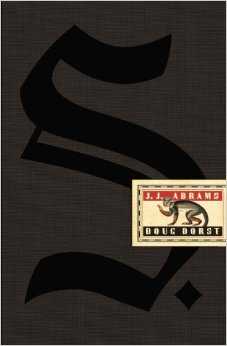S. (Dorst novel)
|
The slipcover of S. | |
| Author | Doug Dorst, JJ Abrams |
|---|---|
| Language | English |
| Publisher | Mulholland Books |
Publication date | October 29, 2013 |
| Media type | Print (Hardback) |
| Pages | 472 |
| ISBN | 0316201642 |
S. is a 2013 novel written by Doug Dorst and conceived by J.J. Abrams. The novel is unusual in its format, presented as a story within a story. It is composed of the novel Ship of Theseus by a fictional author, and hand-written notes filling the book's margins as a dialogue between two college students hoping to uncover the author's mysterious identity and the novel's secret plus loose supplementary materials tucked in between pages.
S. has been called "part work of art, literary experiment, and love letter to the physical expression of books."[1]
Description
S. is presented in the form of a novel called Ship of Theseus written by an elusive author named V.M. Straka and published in 1949. Beyond the black slipcover with the S. title, no reference is made to Dorst or Abrams, and the only reference to the book's true publishing information appears in fine print inside the back cover. The publication information is printed under a mock-up of a high school library's check-out history of the book, spanning the years 1957 to 2000.
Removed from the slipcover, S. is designed to appear entirely as a copy of the standalone novel Ship of Theseus written by Straka that was borrowed from and never returned to the Laguna Verde High School Library. The pages are worn and yellowed with library stamps in the front and back cover and stains on the pages. The book's spine is labeled with a library sticker marking the novel's location number in the Dewey Decimal Classification.
The novel can be read alone in its entirety. Presented as Straka's nineteenth and final novel before his mysterious death, Ship of Theseus tells the story of an amnesiac on a strange journey to discover himself. Straka's enigmatic life and death are considered one of the literary world's greatest mysteries and enshrouded by conspiracy theories and claims of espionage and assassination. His identity is the subject of much scholarly debate as evidenced by a foreword and footnotes from F.X. Caldeira is descirbed as Straka's chosen translator for many of his books including Ship of Theseus, though even Caldeira never encountered Straka face-to-face.[2]
A second storyline takes place in the book's margins. Eric is a disgraced graduate student who has spent his life studying Straka and his literary works. Jen is a college senior contemplating the next step of her life. The two begin to trade a copy of Ship of Theseus back and forth without meeting, using the book's margins to carry out discussions about who Straka was using handwritten notes, arrows, and symbols.[3] The pair hopes to solve the mystery of Straka's identity before Eric's graduate professor, who allegedly stole his research and had him expelled, publishes his research on Straka. Not always chronological, different pen colors and handwriting styles denote the dialogues between the two and how they change on subsequent re-readings on the novel.
Concurrent with Jen and Eric's timeline of reading and annotating the novel, there are postcards, handwritten letters, maps, and photocopied articles and book excerpts physically folded and inserted between the book's bound pages as Jen and Eric provide evidence and clues to each other while exchanging the book.[4]
Development

S. is a collaboration between film producer J.J. Abrams, who came up with the concept for the book, and writer Doug Dorst. Abrams stated that the idea came from finding a book on a bench that had an inscription: ""to whomever finds this book please read it and take it somewhere and leave it for someone else to read."[3] Dorst has stated that his idea for the central concept of the story came from reading about the Shakespeare authorship question and the B. Traven controversy.[5]
The authors purposefully took advantage of the fact that the book was intended as a physical object, Abrams noting that "to physically hold it is kind of the point."[6] One reviewer called S. an argument for paying extra for a physical book, "a possessor of wonders that cannot be translated into digital bits."[1]
References
- ↑ 1.0 1.1 Tsouderos, Trine (November 28, 2013). "Review: 'S.' by J.J. Abrams and Doug Dorst". The Chicago Tribune. Retrieved 3 December 2013.
- ↑ Rothman, Joshua (November 23, 2013). "The Story of “S”: Talking With J. J. Abrams and Doug Dorst". The New Yorker. Retrieved 3 December 2013.
- ↑ 3.0 3.1 DuChateau, Christian (October 30, 2013). "Five Questions: J.J. Abrams & Doug Dorst". CNN. Retrieved 3 December 2013.
- ↑ Hill, Logan (October 27, 2013). "A Long Time Ago, in a Universe More Analog". The New York Times. Retrieved 3 December 2013.
- ↑ Rothman, Joshua (November 23, 2013). "The Story of “S”: Talking With J. J. Abrams and Doug Dorst". The New Yorker. Retrieved 3 December 2013.
- ↑ Hill, Logan (October 27, 2013). "A Long Time Ago, in a Universe More Analog". The New York Times. Retrieved 3 December 2013.
